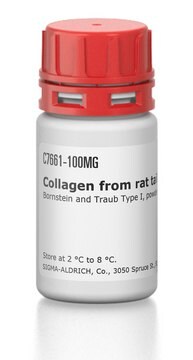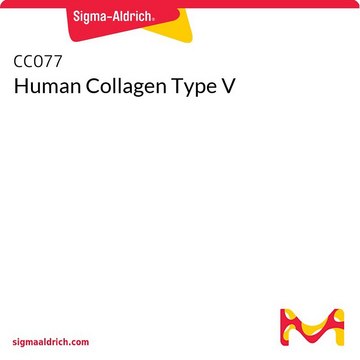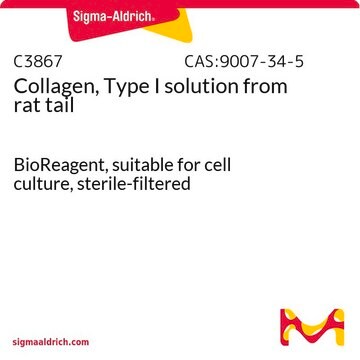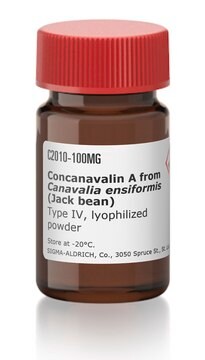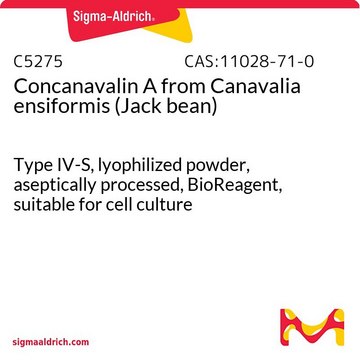C7624
Collagen human
Bornstein and Traub Type I, recombinant, expressed in Nicotiana tabacum (tobacco)
Sinónimos:
Collage™
Iniciar sesiónpara Ver la Fijación de precios por contrato y de la organización
About This Item
Productos recomendados
biological source
human
Quality Level
recombinant
expressed in Nicotiana tabacum (tobacco)
assay
>90% (SDS-PAGE)
form
liquid
concentration
2.5-3.5 mg/mL protein (Sircol method)
technique(s)
cell culture | mammalian: suitable
shipped in
wet ice
storage temp.
2-8°C
Gene Information
human ... COL1A1(1277) , COL1A2(1278)
¿Está buscando productos similares? Visita Guía de comparación de productos
General description
Collagen is classified into a number of structurally and genetically distinct types. We use the nomenclature proposed by Bornstein and Traub. Do not confuse Sigma type designations with recognized collagen classification types.
Physical form
Supplied as a filter-sterilized liquid in 10 mM HCl. Do not freeze.
Preparation Note
Coating of tissue culture dishes: Use 3 to 10 microgram per 1 cm2 dish area. For each cell type and plate type an optimization may be required. Dilute in 10 mM HCl or PBS. Apply the diluted collagen to a tissue culture plate and allow to dry overnight in a laminar flow hood with the plate lid open. Aspirate gently the remaining liquid from the coated wells. Wash twice gently with PBS.
To prepare a collagen gel the fibrillogenesis buffer contains 162 mM sodium phosphate dibasic (Na2HPO4) adjusted to pH 11.2 with 10 N NaOH, filter sterilized. Mix 9 volumes of Collagen at a concentration of 0.3%-1% with 1 volume of fibrillogenesis buffer. Mix well and incubate for 4 to 16 hours at 25°C to 27 °C. Higher concentration of collagen solution might need optimization. Thiis preparation will not spontaneously form a gel in PBS or cell culture medium.
Preparation of collagen sponge: concentrate gel to 10 mg/ml - 100 mg/ml by centrifugation, freeze dry. Crosslink by common methods found in the scientific literature such as 1-Ethyl-3-[3-dimethylaminopropyl]carbodiimide hydrochloride (EDC), Glutaraldehyde or thermal dehydration.
Other forms: membranes, sheets, fibers can be prepared by methods commonly used with other types of collagen.
To prepare a collagen gel the fibrillogenesis buffer contains 162 mM sodium phosphate dibasic (Na2HPO4) adjusted to pH 11.2 with 10 N NaOH, filter sterilized. Mix 9 volumes of Collagen at a concentration of 0.3%-1% with 1 volume of fibrillogenesis buffer. Mix well and incubate for 4 to 16 hours at 25°C to 27 °C. Higher concentration of collagen solution might need optimization. Thiis preparation will not spontaneously form a gel in PBS or cell culture medium.
Preparation of collagen sponge: concentrate gel to 10 mg/ml - 100 mg/ml by centrifugation, freeze dry. Crosslink by common methods found in the scientific literature such as 1-Ethyl-3-[3-dimethylaminopropyl]carbodiimide hydrochloride (EDC), Glutaraldehyde or thermal dehydration.
Other forms: membranes, sheets, fibers can be prepared by methods commonly used with other types of collagen.
Legal Information
Collage is a trademark of CollPlant Ltd.
Storage Class
13 - Non Combustible Solids
wgk_germany
nwg
flash_point_f
Not applicable
flash_point_c
Not applicable
Elija entre una de las versiones más recientes:
¿Ya tiene este producto?
Encuentre la documentación para los productos que ha comprado recientemente en la Biblioteca de documentos.
Collagen: The Fibrous Proteins of the Matrix
Lodish H, et al.
Molecular and Cellular Biology (2000)
Mahboobe Ghaedi et al.
The Journal of clinical investigation, 123(11), 4950-4962 (2013-10-19)
The use of induced pluripotent stem cells (iPSCs) has been postulated to be the most effective strategy for developing patient-specific respiratory epithelial cells, which may be valuable for lung-related cell therapy and lung tissue engineering. We generated a relatively homogeneous
Anne Tristan et al.
PloS one, 4(4), e5042-e5042 (2009-04-07)
Staphylococcus aureus necrotizing pneumonia is a severe disease caused by S. aureus strains carrying the Panton Valentine leukocidin (PVL) genes (lukS-PV & lukF-PV) encoded on various bacteriophages (such as phiSLT). Clinical PVL+ strains isolated from necrotizing pneumonia display an increased
Davide Gibellini et al.
Retrovirology, 8, 40-40 (2011-05-27)
HIV infection elicits the onset of a progressive immunodeficiency and also damages several other organs and tissues such as the CNS, kidney, heart, blood vessels, adipose tissue and bone. In particular, HIV infection has been related to an increased incidence
Michelle K Nguyen et al.
Current opinion in ophthalmology, 24(4), 291-295 (2013-06-06)
To describe the use of corneal collagen cross-linking (CXL) and its efficacy in the stabilization of keratorefractive procedures, including PRK, laser in-situ keratomileusis (LASIK), thermal keratoplasty, and orthokeratology. Since its introduction, CXL has quickly gained interest in the treatment of
Nuestro equipo de científicos tiene experiencia en todas las áreas de investigación: Ciencias de la vida, Ciencia de los materiales, Síntesis química, Cromatografía, Analítica y muchas otras.
Póngase en contacto con el Servicio técnico
